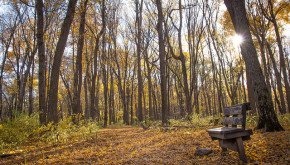
As a women woodland owner or manager I suspect you like trees, feel connected to the woods and likely appreciate the peace and quiet that can be found in that special corner of your woodlot. Intuitively you may recognize some of the health benefits of trees but you will likely be surprised to learn just how much trees are good for us.
In Minnesota we celebrate Arbor Day on the last Friday of April with the rest of the US, but then we also celebrate Arbor Month in May. In 2016 the MN DNR decided to host the State’s Arbor Day & Month festivities in Rochester, MN home of the Mayo Clinic, with a special focus on the human health impacts of trees. As an Extension Forester I feel well informed and am an all around tree advocate; but I still learned a great deal, a truly shocking amount MORE, about just how good trees are for us.
A great 2 minute video about the health benefits of trees can be found here: Get Your Daily Dose of Trees - Health Benefits of Trees. In addition here are some great kernels of new wisdom I learned:
From MN DNR - Arbor Month, May 2016
- Trees & shrubs can reduce stressful noises by 50%.
- Exposure to forests decreases mental fatigue by relaxing and restoring the mind, and lowers blood pressure and heart rate.
- Kids who play in nature are more relaxed and attentive, which improves learning and performance in school.
- Childhood asthma rates are lower in urban neighborhood that have a higher density of trees.
- In 50 years one tree provided $62,000 worth of air pollution control.
- Nature helps patients refocus their attention and increase their pain thresholds, leading to improved coping and healing strategies.
From Green Cities: Good Health at the University of Washington:
- Hospital patients with plants in their room display less fatigue and pain, shorter hospitalization, less anxiety, and higher hospital and room satisfaction.
- Gardening may be a preventative measure to help reduce the onset of dementia; gardening on a daily basis was found to reduce risk factors for dementia by 36%.
- A study of children with Attention Deficit Disorder who played in windowless indoor settings had significantly more severe symptoms than those who played in grassy, outdoor spaces.
- Exposure to nearby nature can effectively reduce stress particularly if initial stress levels are high. Simply having a view of nature produces recovery benefits.
- Ever more studies confirm the relationship between neighborhood open space and physical activity. A study calculated a $2,200 reduction in average annual healthcare charges per adult for those who had been sedentary, but became active.
There’s much, much more about the social, economic, safety and public health impacts of trees at Green Cities: Good Health including this teaser: “The presence of larger trees in yards and as street trees can add from 3% to 15% to home values throughout neighborhoods.”
Heading out to hug a tree and breath deeply.
Featured photo at top of article by Eli Sagor, University of Minnesota.


